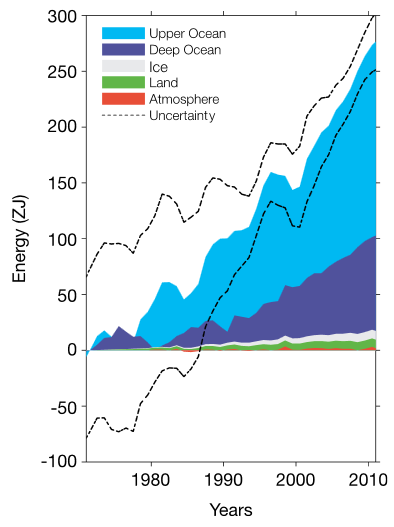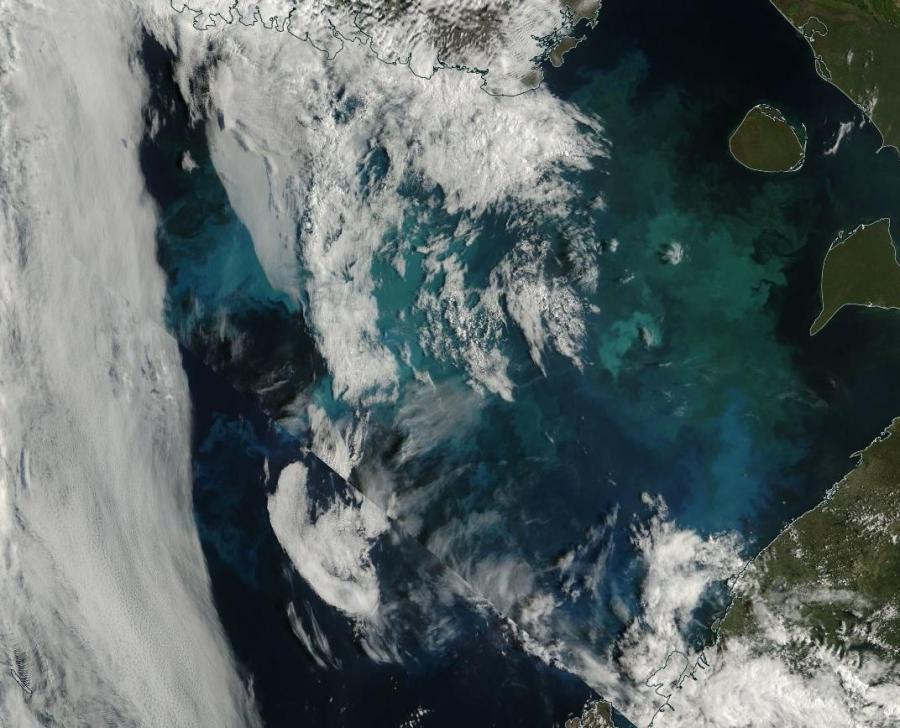New Report: ‘Blowtorch’-
Like Ocean Warming
Advances Killer Seas, Shifts
El Nino, Heats Hydrates
Tampering
can be dangerous. Nature can be vengeful. We should have a great deal
of respect for the planet on which we live.
But
as the [IUCN] study points out,
90% of the extra heat that our greenhouse gases trap is actually
absorbed by the oceans. That means that the upper few meters of the
sea have been steadily warming more than a tenth of a degree celsius
per decade, a figure that’s accelerating. When you think of the
volume of water that represents, and then try to imagine the energy
necessary to raise its temperature, you get an idea of the blowtorch
that our civilization has become.
— Bill
McKibben
The scale of ocean warming is truly staggering with the numbers so large that it is difficult for most people to comprehend.
The scale of ocean warming is truly staggering with the numbers so large that it is difficult for most people to comprehend.
— from the IUCN
report Explaining
Ocean Warming: Causes, scale, effects and consequences
*****
18
August, 2016
If
there’s one simple fact about past Earth climates that should keep
you awake at night, it’s this — warming the world ocean
eventually produces a killing mechanism that is unrivaled by any
other in Earth’s deep past. Great asteroids, gamma-ray bursters,
earthquakes, tsunamis and volcanism — none of these can rival the
vast damage to life on planet Earth that is resulting from ocean
warming.
As
a study of the sciences, this assertion would be merely an academic
one if the human race weren’t now involved in a great injection of
an unprecedented volume of greenhouse gasses into the Earth’s
airs. As
a critical new ocean report from the International Union for
Conservation of Nature (IUCN) points out, these
gasses are trapping an extraordinary amount of heat at the top of the
world’s atmosphere. In
turn, the atmosphere is transferring the lion’s share of this heat
— more than 90 percent — into the waters of our world.
The
Extreme Amount of Heat Energy Piling up in Our Warming Ocean
As
a result, the
surface of the world ocean is warming by 0.1 degree Celsius per
decade.
That may not sound like much, but it takes about four times the
amount of energy to warm one gram of water by 0.1 C as it does one
gram of air. This property, called specific heat, is a defining
aspect of water. Water
has the highest specific heat of any common substance.
(Since
the 1970s, about 300 zettajoules’ (ZJ) worth of heat energy has
accumulated in the Earth System due to fossil-fuel burning and
related greenhouse gas emissions. That’s about 5 Hiroshima bombs
worth of heat accumulating every second. Most of that energy has gone
into the world’s oceans. So much heat is bound to have
consequences, and these impacts are starting to show up in the form
of declining ocean health, melting sea ice and glaciers, shifting
climate zones and weather patterns, worsening droughts and storms,
and threats of Earth System carbon feedbacks. Image
source: Explaining
Ocean Warming.)
Liquid
water is also far denser than air. And this density generates an even
higher impact heat energy transfer multiplier. So not only does it
take four times more energy to warm a similar weight of water vs air,
once warmed, that water contains that higher level of specific heat
energy in a much more tightly concentrated package. And when that
high heat concentration liquid water comes into contact with other
substances — like ice in the form of ocean contact, or air in the
form of evaporation, or frozen hydrates on the sea bed — it can
pack a serious heat punch.
The
vast volume of water in our oceans, therefore, serves as a kind of
heat and energy regulator. It takes a lot of energy to warm it up,
but once it does, serious environmental changes start to happen as a
result. In other words, the temperature of the global ocean could be
viewed as the point on which the whole of the Earth climate system
pivots. Once the oceans are set in thermal motion, serious changes to
the rest of the world are going to take place. To get an idea how
much energy the oceans now contain, of how much potential they now
have to dramatically alter our world, consider that if
these vast waters were not present, the atmosphere now would have
already warmed by 36 degrees C due to the heat-trapping effect
of greenhouse gasses already in our atmosphere.
Fossil-fuel
blowtorch indeed.
Heating
Seas Ultimately Become Killer Seas
There’s
a starker message to convey here, one that focuses on this simple yet
dire question — how do warming oceans kill? In
basic terms, they become toxic and anoxic.
Warming oceans melt ocean-contacting glaciers. The glacial melt
forces seas to rise and forms a freshwater lid on the global ocean,
breaking down ocean conveyor belts and preventing mixing. This
freshwater lid also deflects heat toward the ocean bottom. This
process in turn helps to thaw methane hydrates. Warm waters that
don’t mix and that are filled with bubbling hydrates become very
oxygen-poor.
(Massive
algae bloom covers tens of thousands of square miles of open water in
the Barents Sea during August of 2016. As glaciers melt, oceans
stratify and warm; as water oxygen levels drop, and as hydrates vent
due to warming, such blooms result in significant reductions to ocean
health and a related global mass-extinction threat. Image
source:LANCE
MODIS.)
As
the land glaciers bleed out into the oceans, the stratified,
oxygen-deprived waters become less and less able to support advanced
life. The kinds of life warm, oxygen-deprived waters do support are
poison-producing microbes. These microbes thrive in the warm,
oxygen-poor waters. If ocean heating continues to progress, the
warming seas will eventually fill up with their deadly
byproducts. Among
the most nasty of these is hydrogen sulfide.
If enough of it is produced, it will spill out from the ocean
into the nearby air, resulting in land animal mortality as well.
In
microcosm, we
saw a mild taste of some of these effects this past year in
Florida as
toxic algae blooms filled the warming state’s waterways and
coastlines, even forcing some riverside marinas to close due to toxic
gasses wafting up from the purple-green, oxygen-starved waters. These
effects are a snapshot of a possible future for Earth’s oceans if
we don’t get our act together yesterday.
El
Niño Shifted, Ocean Hydrates Threatened
As
alluded to earlier in this post, a new report, Explaining
Ocean Warming, provides
some pretty hard evidence that the oceans are on the move toward a
much more harmful global climate state. The study, which has rightly
received a great deal of media attention, issues a ‘shot across the
bow’ warning to pretty much everyone living today. And
it finds serious impacts to the ocean and linked climate systems due
to a very rapid human-forced global warming.
These
hard findings are worth reading directly:
Sea-surface temperature, ocean heat content, sea-level rise, melting of glaciers and ice sheets, CO2 emissions and atmospheric concentrations are increasing at an accelerating rate with significant consequences for humanity and the marine species and ecosystems of the ocean.
There is likely to be an increase in mean global ocean temperature of 1-4 degrees C by 2100. The greatest ocean warming overall is occurring in the Southern Hemisphere and is contributing to the subsurface melting of Antarctic ice shelves. Since the 1990s the atmosphere in the polar regions has been warming at about twice the average rate of global warming.
There is likely to be Arctic warming and ice loss, and possibly the essential removal, in some years, of the summer Arctic sea ice within the next few decades.
Over the last 20 years there has been an intensification and distinct change in the El Niño events, with a shift of the mean location of sea-surface temperature anomalies towards the central Pacific.
Currently 2.5 Gt of frozen methane hydrate are stored in the sea floor at water depths of 200 to 2000 m. Increasing water temperature could release this source of carbon into the ocean and ultimately into the atmosphere.
These
are all Earth-shattering scientific statements. For those who
frequent this blog, points 1 through 3 are probably pretty familiar.
The last two, however, require more in-depth explanation.
(Some
scientific studies have pointed out that warming the world ocean will
result in a shift of El Niño toward the central Pacific. A new ocean
report finds that it’s already happening. Image source: Global
Warming May Dent El Niño’s Protective Hurricane Shield, Increase
Droughts.)
For
a long time now, scientists have believed that El Niño wouldn’t
be affected by climate change until the end of this century. But as
with sea ice, it appears that such impacts may well be advancing
faster than expected. As we’ve alluded to here, there’s been an
apparent shift in El Niño toward the central Pacific over recent
decades. This may well be a climate change-related shift. The fact
that the IUCN report highlights this change is a sign that
the broader sciences are starting to tackle the notion of early
alterations to El Niño due to climate change as well.
However,
the most ominous language here centers around methane hydrate. For
years, there’s been adamant push-back against potential risks to
hydrates coming from well-respected sections of the climate sciences.
Nonetheless, those downplaying the threat of warming to hydrates have
yet to produce any conclusive proof as to why warming the ocean
bottom and applying heat to hydrates won’t result in at least some
feedback from these carbon stores (especially under the higher-range
warming scenarios). The IUCN report reiterates this risk by
identifying 2.5 billion tons of frozen seabed methane at shallow and
mid-ocean depths that will ultimately be exposed to warming —
risking both an ocean and an atmospheric release.
These
last points serve to underline some pretty basic facts, the chief of
which is that pushing Nature, and heating up her life-blood world
ocean waters, is a very, very dangerous game. And if this
poignant new report sends
any message at all it could simply boil down to this — turn
back before it’s too late.
Links:
IUCN
Report: Explaining
Ocean Warming
Hat
tip to Cate
Hat
tip to George Hayduke







No comments:
Post a Comment
Note: only a member of this blog may post a comment.